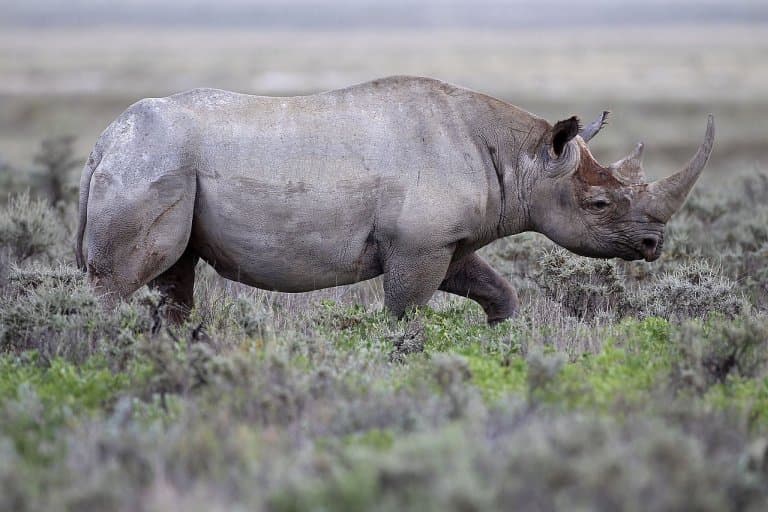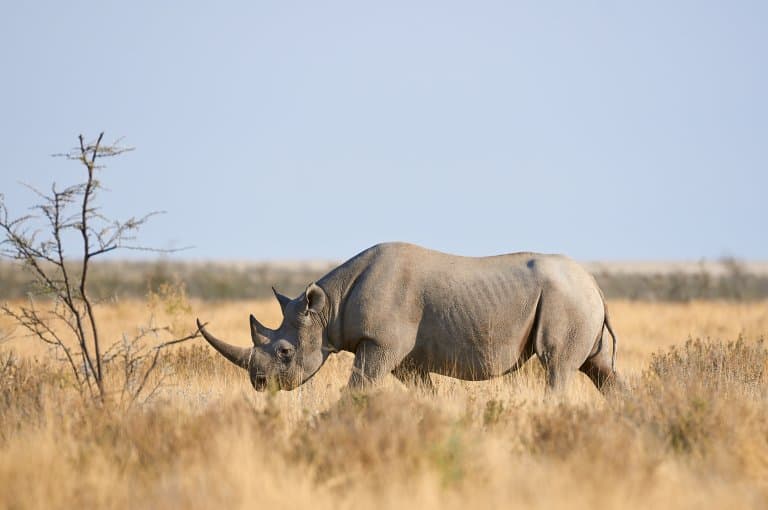West African Black Rhino Profile
Black rhinos are a critically endangered species of African rhinoceros and are among the last remaining megafauna. As their populations suffer, the number of individuals in the species hovers around 3,000 across the vast African continent.
Fortunately, this number does appear to be on the rise thanks to expensive and concentrated conservation efforts.
Perhaps the species is even set to make a glorious recovery; sadly, at least one subspecies won’t be around to enjoy it: the West African Black Rhino is one of our most recent and most iconic losses to extinction.

West African Black Rhino Facts Overview
| Habitat: | Savanna and shrubland |
| Location: | Central and Western Africa |
| Lifespan: | 50 years |
| Size: | 1.8m (6ft) tall, 3.75m (12ft) long4 |
| Weight: | 1.4 tons (3000 lb) |
| Colour: | Grey |
| Diet: | Browser of shrubs |
| Predators: | Humans, hyenas, lions |
| Top Speed: | 45km/h (28mph) |
| No. of Species: | 1 |
| Conservation Status: | Extinct |
Experts typically agree there are seven or eight subspecies of black rhino in total. 3 have become extinct, including the Western Black Rhino, while others are on the verge of extinction.
The Western Black Rhino was a long-legged savanna expert.
Once spanning a disputed range that may have exceeded that of any other subspecies, it became the target of poachers and trophy hunters and was eliminated from its vast landscape in just over a century.
The extinction of this incredible animal illuminates the intricate and global nature of the issue of poaching, and its complexities on an environmental, social, and economic level.
Interesting West African Black Rhino Facts
1. They may have been the most widespread rhinos
The historical range of this subspecies is a matter of debate, and this is in no small part down to conservation efforts.
Many countries deny the release of information into their populations and distribution as a way of keeping their locations secret.
So, while the range isn’t clear, this subspecies was thought to traverse savanna regions across the widest parts of Africa, ranging coast to coast from the Red Sea to Lagos, and from the Algerian Sahara to the Congo Rainforest.
The previous range of this subspecies is disputed, but rock paintings, artwork, and engravings give evidence of their existence in various parts of West Africa, but it’s likely the true distribution will forever be lost to time. 1 2
2. Longfoot
This subspecies of black rhino was distinctive from its more Southerly counterparts by a longer distal (hand) part of its leg.
This quirk became characteristic of its subspecies and lent it the name longipes, meaning “long foot”, and it might suggest that the subspecies was even faster than the average black rhino.
The species as a whole has been clocked at 45km/h at full pace, significantly faster even than an elephant, the only African land mammal heavier than it is.
Rhinos in general may look lumbering and fat, but they have remarkable speed and stamina for their bulk, and the Western Black rhino may have been an exceptional case. 3
3. Square horn
Another thing that stood out (literally) on this animal was the horn itself. These were large and bulky protrusions, and unlike on other subspecies, they had a square base.
This horn would have been used to defend itself against many of the normal African threats of the Pleistocene, but in a cruel irony, it became the very driver of the animal’s predation by humans.
4. There used to be over a million black rhinos
There are up to eight subspecies of black rhino, the Western Black rhino being one of three that has recently become extinct.
In 2011, the IUCN survey failed to find a single individual and declared the subspecies extinct.
This extinction contributed to the loss of black rhinos from numbers reaching one million in 1,900 to 2,300 in 2001.
Since then, an incredible collaborative effort from global conservation programs has secured various remaining populations of the species and led to increasing numbers in some regions, but the threat of extinction still looms for these, too.

5. Their horns helped people?
Rhino horn is collected primarily as a medicine – one for which there is no evidence to support its use. Still, while the relentless consumers of the horn gain no tangible benefit from it, the poachers who procure it often do.
Such is the price of a rhino horn due to idiotic and unfounded demand from Vietnam and China, that an impoverished hunter from any number of African countries can pull his family from poverty overnight with a single kill.
But the reality is that, while they will still make good money, the hunters are more likely to be exploited by large-scale criminal gangs, who will keep most of the possible $400,000-per-kilo of horn for themselves. Meanwhile, rhinos are being driven quickly to extinction for a fantasy cure.
This is what led to the extinction of the West African black rhino, and is still the biggest threat to the species as a whole. A combination of global wealth inequality, anti-science sentiment, poverty and greed creates a powerful and devastating effect on large mammal populations worldwide. 4
6. More rhino horns on the market could return rhinos to West Africa
Some groups are pushing for more relaxed laws on rhino horn gathering and distribution, with the idea that flooding the market will reduce the value of the horn, weaken the black market, and allow sanctuary owners to help fund their programs.
Further, it’s been suggested that the more available this material is as a medicine, the more first-hand evidence there will be that it just doesn’t work, and this, too, should reduce demand.
The legal trade in rhino horn may not come soon enough to save the West African black rhino, but it may save the species as a whole, and contribute somewhat to the restoration of the Western’s habitat as a place where rhinos can once again roam. 5

7. Subspecies can often fill niches just as well
All is not entirely lost for the habitat of the Western black rhino. While genetic pipedreams may one day pull through for the field of de-extinction, they remain an expensive long shot.
But studies have shown that closely-related subspecies can sometimes be substituted into the habitats of their deceased relatives with some success.
The more recently they separated from the extinct animal, and the more recently the habitat has suffered its loss, the easier this might be.
The trouble in this case, and in any case of reintroduction, however, is that the very factors that led to the extinction in the first place are still present.
This means that bringing back the extinct animal (or its close analogue) will simply result in the same fate, and this is where the major problem of conservation persists.
Without a change in approaches, an increase in stability, and a change in attitudes towards our wildlife, the range of the Western Black rhino will remain devoid of its presence.
Hopefully, over time, the protections afforded to Southern populations that have become so successful will spread Northward through the continent. 6
West African Black Rhino Fact-File Summary
Scientific Classification
| Kingdom: | Animalia |
| Phylum: | Chordata |
| Class: | Mammalia |
| Order: | Perissodactyla |
| Family: | Rhinocerotidae |
| Genus: | Diceros |
| Species: | Diceros Bicornis |
| Subspecies: | Diceros Bicornis Longipes |
Fact Sources & References
- L.C. Rookmaaker (2003), “Historical distribution of the black rhinoceros (Diceros bicornis) in West Africa”, Rhino Resource Center.
- “Western Black Rhino”, IUCN Red List.
- Brianna Cowling, “Western Black Rhinoceros: Characteristics & Extinction”, Study.com.
- John R. Platt (2013), “How the Western Black Rhino Went Extinct”, Scientific American.
- Vu Hoai Nam Dang (2022), “Rhino horn consumers reveal why a legal trade alone won’t save rhinos”, Down to Earth.
- Philip J. Seddon (1999), “Guidelines for Subspecific Substitutions in Wildlife Restoration Projects”, JSTOR.
